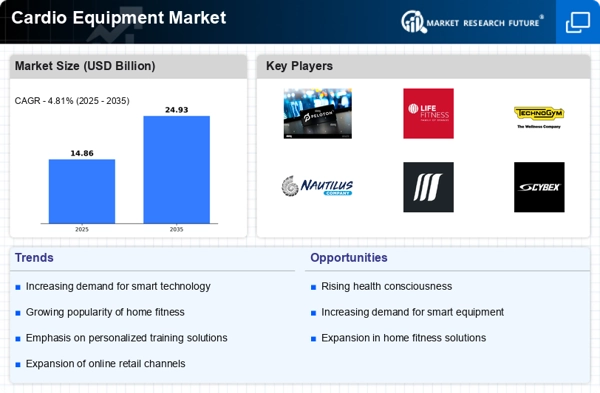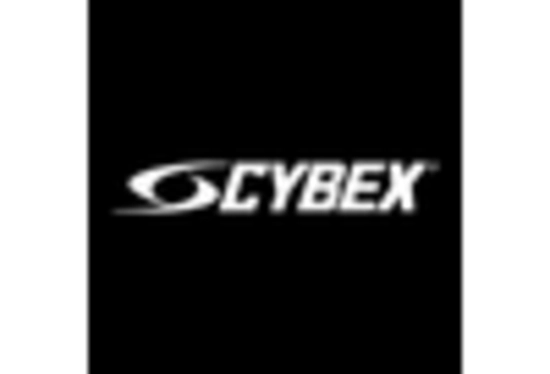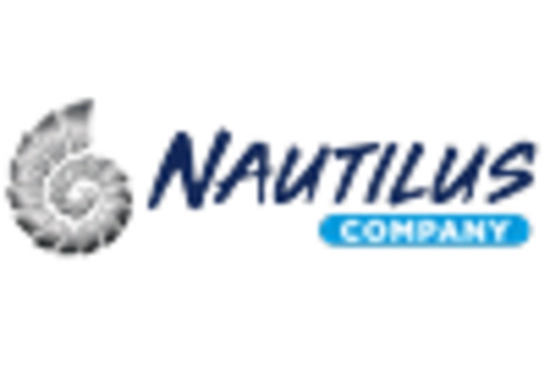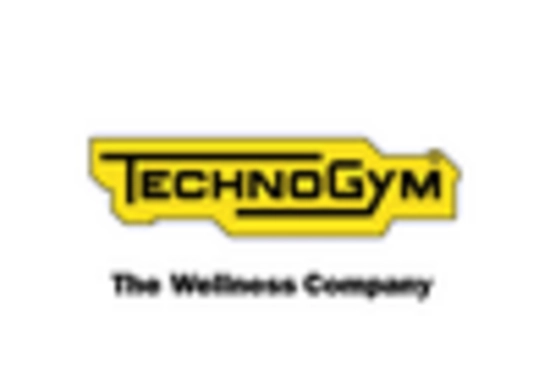Aging Population
The aging population is a significant demographic factor influencing the Cardio Equipment Market. As life expectancy increases, there is a growing emphasis on maintaining health and fitness among older adults. This demographic shift suggests that there is a rising demand for cardio equipment tailored to the needs of seniors, such as low-impact machines that promote cardiovascular health without excessive strain. Data indicates that individuals aged 65 and older are increasingly engaging in regular physical activity, which may lead to a surge in demand for specialized cardio equipment. Manufacturers are likely to respond by developing products that cater specifically to this age group, thereby expanding their market offerings and addressing the unique health concerns of older adults.
Technological Advancements
Technological innovations in the Cardio Equipment Market are transforming the way consumers engage with fitness. The integration of advanced features such as heart rate monitoring, interactive displays, and connectivity with mobile applications is becoming increasingly prevalent. Data indicates that the market for smart fitness equipment is expected to grow significantly, with projections suggesting a compound annual growth rate of over 20% in the coming years. These advancements not only enhance user experience but also provide valuable insights into personal health metrics, encouraging users to maintain their fitness regimes. As technology continues to evolve, manufacturers are likely to invest in research and development to create more sophisticated cardio equipment, thereby attracting tech-savvy consumers and expanding their market reach.
Increasing Health Awareness
The rising awareness regarding health and fitness among individuals appears to be a primary driver for the Cardio Equipment Market. As more people recognize the importance of maintaining cardiovascular health, the demand for cardio equipment is likely to surge. According to recent data, approximately 60% of adults engage in some form of physical activity, which correlates with an increased interest in home and commercial fitness solutions. This trend suggests that consumers are investing in cardio equipment to enhance their fitness routines, thereby propelling market growth. Furthermore, educational campaigns and initiatives by health organizations are fostering a culture of fitness, which may further stimulate demand for cardio equipment. As a result, manufacturers are likely to innovate and diversify their product offerings to cater to this growing consumer base.
Growth of Fitness Centers and Gyms
The proliferation of fitness centers and gyms is another notable driver for the Cardio Equipment Market. As urbanization continues to rise, more individuals are seeking convenient access to fitness facilities, leading to an increase in gym memberships. Recent statistics indicate that the number of fitness centers has grown by approximately 10% annually, reflecting a robust demand for cardio equipment in these establishments. This trend suggests that gym owners are likely to invest in high-quality cardio machines to attract and retain members. Additionally, the growing popularity of group fitness classes and personal training sessions may further drive the need for diverse cardio equipment options. Consequently, this expansion in fitness facilities is expected to bolster the overall market for cardio equipment.
Emergence of Online Retail Channels
The emergence of online retail channels is reshaping the purchasing landscape for the Cardio Equipment Market. With the increasing prevalence of e-commerce, consumers are now able to access a wider range of cardio equipment options from the comfort of their homes. Recent data suggests that online sales of fitness equipment have surged, with projections indicating a growth rate of over 15% in the next few years. This shift towards online shopping is likely to encourage manufacturers to enhance their digital presence and invest in online marketing strategies. Additionally, the convenience of home delivery and the ability to compare products easily may further drive consumer interest in purchasing cardio equipment online. As a result, this trend is expected to significantly impact the overall dynamics of the cardio equipment market.


















Leave a Comment